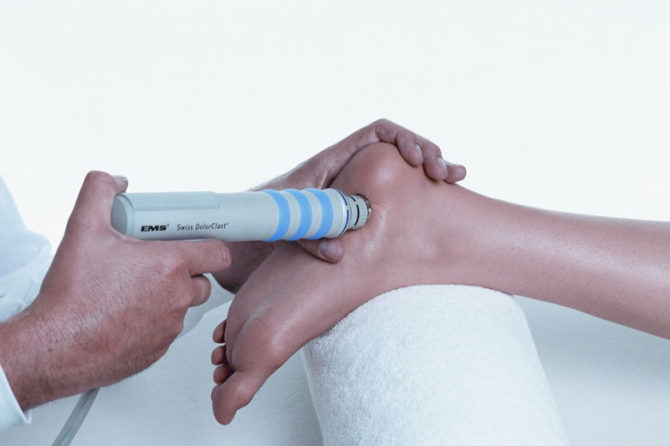
Dolorclast Extracorporeal Shockwave Therapy (ESWT)
 What is Extracorporeal ShockWave Therapy (ESWT)?
What is Extracorporeal ShockWave Therapy (ESWT)?
Shockwave therapy has been used for treatment of musculoskeletal conditions since the early 1990s. Originating from a urology procedure called ʻlithotripsyʼ (used to treat kidney stones), it is a safe and non- invasive therapy. Shockwave therapy has shown evidence in promoting pain relief and also tendon remodeling/ regeneration.
What is involved?
Radial Shockwaves are transmitted to the site of injury via a hand-piece held by the clinician. Treatment over the area of injury may cause some initial discomfort. It is not uncommon for patients to develop numbness or heaviness in this area at the time of treatment. Occasionally it may cause temporary redness or bruising
Each treatment will take a duration of approximately 10minutes and 2000-3000pulsed shockwaves will be administered to the area of concern. Patients typically need 3-5 treatments though improvement can be achieved after a single treatment.
 What is it used to treat?
What is it used to treat?
Plantar Fasciitis/Heel Spurs
Tendon injuries
Shin splints
Contra-indications
Whilst very safe, shockwave therapy is contra-indicated in the following conditions
- Pregnancy
- Bleeding disorders
- Warfarin therapy
- Tumors
- Local inflammation/wound
Evidence
Scientific research supports the use of shockwave therapy in the treatment of tendinopathy, plantar fasciitis and other conditions.
Selected Research Articles
Rompe et al (2008) Eccentric loading compared with shock wave treatment for chronic insertional achilles tendinopathy. J Bone Joint Surg Am, 90:52-61
Han et al (2009) Effect of extracorporeal shock wave therapy on cultured tenocytes, foot and ankle
International. 30:93-98
Furia et al (2007) Extracorporeal shock wave therapy in the treatment of chronic plantar fasciitis and Achilles tendinopathy. Current Opin Orthop, 18:101-111
Huisstede et al (2011) Evidence for effectiveness of Extracorporal Shock-Wave Therapy (ESWT) to treat calcific and non-calcific rotator cuff tendinosis–a systematic review. Man Ther. Oct;16(5):419-3
Farr et al (2011) Extracorporeal shockwave therapy in calcifying tendinitis of the shoulder. Knee Surg Sports Traumatol Arthrosc. 2011 Dec;19(12):2085-9.
Notarnicola et al (2012) The Biological effects of extracorporeal shock wave therapy (eswt) on tendon tissue. Muscles Ligaments Tendons J. Jun 17;2(1):33-7.
Mani-Babu et al (2014) The Effectiveness of Extracorporeal Shock Wave Therapy in Lower Limb Tendinopathy: A Systematic Review Am J Sports Med published online May 9, 2014
Maffulli et al (2014) Assessment of the Effectiveness of Extracorporeal Shock Wave Therapy (ESWT) For Soft Tissue Injuries (ASSERT): An Online Database Protocol. Transl Med UniSa. 2014 Apr 8;10:46-51. eCollection 2014 Sep.
Leave a reply